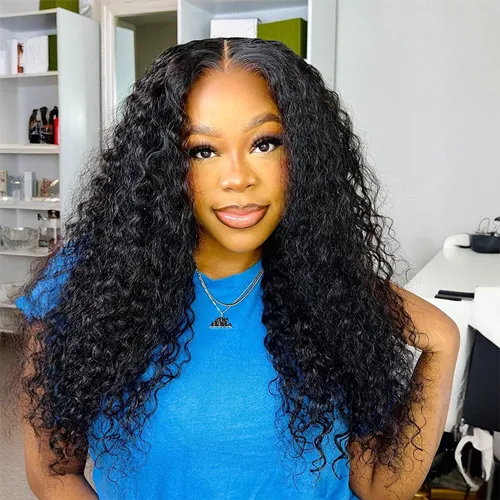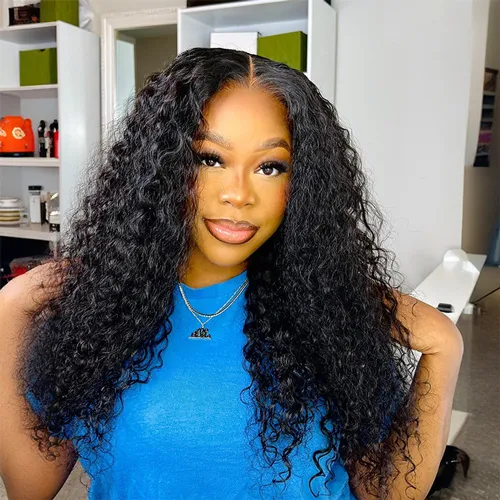Are Curly Wigs Harder To Maintain?
When it comes to styling and maintaining wigs, the texture plays a pivotal role in determining the care they require. Curly wigs or curly human hair wigs, with their unique set of challenges, often prompt the question: Are they harder to maintain than their straight or wavy counterparts? The answer is nuanced, depending on various factors including the type of fibers, the quality of the wig, and your personal maintenance routine. However, it’s generally accepted that curly wigs do require a bit more attention to keep them looking their best. Let’s explore why this is and how you can effectively care for them.

How to define curly wigs?
Curly wigs come in a range of curls, from loose waves to tight kinky curls. The nature of these curls means that the hair fibers are more prone to tangling and matting compared to straight hair, which naturally contributes to a higher maintenance requirement. Additionally, the curls can lose definition and become frizzy if not properly cared for.
Challenges in maintaining curly human hair wigs.
Maintaining curly human hair wigs indeed presents specific challenges that require careful attention and a tailored care routine to ensure longevity and preserve the natural look of the curls. Here are some of the primary challenges you might encounter while maintaining curly human hair wigs:
1. Tangling and matting.
Curly hair, by its nature, is more prone to tangling because of the curls and twists in the fibers. This can lead to knots and matting, especially at the nape of the neck or in areas where friction is common. The more tangled the wig, the harder it is to restore without causing damage.
2. Frizz.
Frizz is a common issue with curly wigs due to factors like humidity, dryness, and friction. Curly human hair wigs can become frizzy when the cuticle layers of the hair fibers don’t lie flat, leading to a puffy and less defined appearance. Managing frizz is crucial in maintaining the aesthetic quality of curly human hair wigs.
3. Maintaining curl definition.
Keeping the original curl pattern intact can be challenging. Over time and with handling, the curls can loosen or become irregular, leading to a decrease in the overall aesthetic appeal of the wig. Products used to define and maintain curls can build up, requiring careful cleaning to avoid weighing down the hair.
4. Dryness.
Curly hair tends to be drier than straight hair because the natural oils produced by the scalp have a harder time traveling down the twists and turns of curly hair strands. Even though wigs do not produce natural oils, synthetic or processed human hair still requires moisture to maintain elasticity and shine. Dryness can lead to breakage and a lackluster appearance.
5. Shedding.
While all wigs experience some shedding, curly wigs might seem to shed more because every time the hair is combed or detangled, some fibers are pulled out. The process of detangling can stress the wig cap and hair fibers, especially if not done gently and properly.
6. Routine intensity.
The maintenance routine for curly wigs is often more labor-intensive compared to straight or wavy wigs. Curly wigs require regular moisturizing, careful detangling, and specific drying methods to maintain their look and health, demanding more time and specific products.
7. Product build-up.
Curly wigs often require products to help maintain curl definition and reduce frizz. However, these products can build up over time, attracting dirt and reducing the natural luster of the wig. Regular cleansing with the right products is essential to prevent build-up and keep the wig looking fresh.

Tips for maintaining curly wigs.
1. Gentle detangling.
Use the right tools: Always opt for a wide-tooth comb or your fingers to detangle your curly wig. This minimizes breakage and helps maintain the curls’ natural shape.
Detangle properly: Start from the ends of the hair and work your way up to the roots gently. Doing this in sections and while the wig is damp with conditioner can make the process easier and more effective.
2. Proper washing
Wash sparingly: Unlike natural hair, wigs do not need to be washed frequently. Overwashing can strip them of moisture, leading to dryness and frizz.
Use appropriate products: Use a sulfate-free shampoo that is gentle on the wig. After shampooing, apply a moisturizing conditioner to help define the curls and maintain the wig’s moisture balance.
Wash correctly: Always wash the hair in a downward motion to prevent tangling. Avoid scrubbing or bunching the hair which can disrupt the curl pattern.
3. Deep conditioning.
Regular sessions: Apply a deep conditioner every few weeks to replenish moisture, especially if the wig starts to feel dry or looks dull.
Leave-in conditioner: Between washes, use a leave-in conditioner or a curl activator to keep the curls well-defined and nourished.
4. Moisturizing.
Hydrate the hair: Since curly wigs tend to dry out faster, applying light oils or silicone-based serums can help lock in moisture and add a protective layer, reducing frizz.
Avoid heavy products: Steer clear of heavy oils and creams that can weigh down the curls and lead to buildup.
5. Drying techniques.
Air dry when possible: Let your wig air dry on a wig stand to preserve the integrity of the curls. Avoid wringing or rubbing the hair to dry it.
Diffuse if needed: If you must use a dryer, attach a diffuser and set it on a low heat setting. This helps to evenly distribute the heat and maintain the curl pattern without causing frizz.
6. Proper storage.
Use a wig stand or mannequin: Store your curly wig on a wig stand or mannequin head when not in use. This helps maintain the shape of the curls and prevents tangling and flattening.
Avoid compression: Never store your wig compressed under heavy items or folded, as this can deform the curls.
7. Nighttime care.
Protect the wig: If you wear your curly wig to bed, consider wrapping it in a silk or satin scarf or use a silk pillowcase. This reduces friction and helps prevent tangling and frizz.
8. Regular maintenance checks.
Trim the ends: Occasionally trimming the ends of the wig can prevent split ends from traveling up the hair shaft, which is crucial for maintaining the overall health of the wig.
Refresh curl pattern: Use curl rejuvenating sprays or light mists to refresh curls between washes without weighing them down.
How long does the curly huamn hair wigs need to wash or condition?
The frequency of washing and conditioning a curly human hair wig depends on several factors, including how often it’s worn and the environment in which it’s used. Generally, it is recommended to wash a curly human hair wig every 7 to 14 days if you wear it daily. If you use a lot of styling products or are in environments where the wig may absorb odors or get dirty more quickly, you might need to wash it more frequently. When washing, it’s crucial to use a sulfate-free shampoo and a hydrating conditioner to maintain the moisture and integrity of the curls.
Additionally, applying a deep conditioner every 2 to 4 weeks can help maintain the wig’s health and vitality, especially if it tends to dry out or lose its bounce. Keeping this schedule helps ensure that the wig stays clean and vibrant without stripping away its natural oils and moisture.
How long does the normal curly human hair wigs service life if we take good care it?
The lifespan of a curly human hair wig, when properly cared for, can typically range from one to three years. The key to maximizing its longevity lies in maintaining a diligent care routine which includes gentle washing, deep conditioning, and proper storage. Factors such as the frequency of wear, the level of styling product use, and exposure to harsh environments can also influence the wig’s durability.
By avoiding excessive heat styling, minimizing tangling and frizz through regular moisturizing, and using products suited for curly hair, you can significantly extend the life of the wig. Regular maintenance, like occasional trims to remove split ends and refreshing the curls to maintain their bounce and shape, also contributes greatly to keeping the wig looking vibrant and healthy over time.
